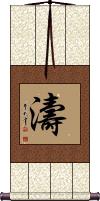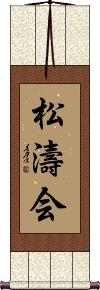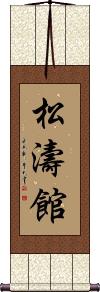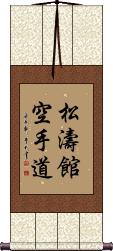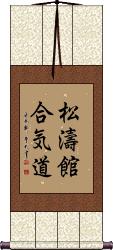Many custom options...
And formats...

濤 in Chinese / Japanese...
Buy an 濤 calligraphy wall scroll here!
Personalize your custom “濤” project by clicking the button next to your favorite “濤” title below...
Big Wave
濤 is the Chinese character for “Big Wave.”
It suggests a wave unlike most, strong and powerful.
濤 is technically also a Japanese Kanji, and Korean Hanja but it's not commonly used in those Asian languages. Pronunciation in Japanese and Korean is provided above for reference only. Just order this if your audience is Chinese.
Chung Do Kwan
靑濤館 is the Korean martial arts style, Chung Do Kwan, meaning “Blue Wave School.”
If you want this in modern Korean Hangul characters, click on the Hangul next to the Korean flag above instead of the button above.
Also Romanized as “Cheong Do Gwan” or “Ch'ŏng Do Kwan.”
Shotokai
Shotokan
松濤館 are the Kanji characters that make up the title for Shotokan.
This should be considered a Japanese-only title. It does make sense and is pronounceable in Chinese and Korean but only as a title for a building (perhaps a martial arts hall) surrounded by pine trees. Also, the first two characters were simplified in both Japanese and Chinese. The third character was simplified in Chinese but not Japanese.
Upon request, we can offer the fully traditional Chinese version but be sure you know what you are asking for.
Note: This would be understood in Chinese and Korean Hanja by a person from those cultures who is familiar with martial arts and various schools of Japanese karate.
Shotokan-Ryu
Martial arts term
Goju Shoto-Ryu
Shotokan Karate-Do
鬆濤館空手道 art the Japanese Kanji that make up the title for Shotokan Karate.
This should be considered a Japanese-only title. It does make sense and is pronounceable in Chinese and Korean but only as a title for a building (perhaps a martial arts hall) surrounded by pine trees - followed by the characters for “The empty hand method” (kong shou dao / Karate-do). Also, the first two characters were simplified in both Japanese and Chinese. The third character was simplified in Chinese but not Japanese.
Upon request, we can offer the fully traditional Chinese version but be sure you know what you are asking for.
Note: This would be understood in Chinese and Korean Hanja by a person from those cultures familiar with martial arts and various schools of Japanese karate.
Shotokan Aikido
松涛館合気道 is the title for Shotokan Aikido in Japanese.
Note: Chinese and Korean pronunciations of these characters are included above, however, this title would only be understood in Chinese or Korean by someone who practices or is familiar with Shotokan Aikido. Please consider this title to be “Japanese only.”
Not the results for 濤 that you were looking for?
Below are some entries from our dictionary that may match your 濤 search...
| Characters If shown, 2nd row is Simp. Chinese |
Pronunciation Romanization |
Simple Dictionary Definition |
濤 涛 see styles |
tāo tao1 t`ao tao nami なみ |
More info & calligraphy: Big Wavewave; (surname, female given name) Nami |
松濤館流 see styles |
shoutoukanryuu / shotokanryu しょうとうかんりゅう |
More info & calligraphy: Shotokan-Ryu |
世濤 世涛 see styles |
shì tāo shi4 tao1 shih t`ao shih tao |
stout (beer) (loanword) |
京濤 see styles |
kyoutou / kyoto きょうとう |
(personal name) Kyōtou |
千濤 see styles |
chinami ちなみ |
(personal name) Chinami |
夜濤 see styles |
yatou / yato やとう |
(personal name) Yatou |
大濤 see styles |
daitou / daito だいとう |
(personal name) Daitou |
尚濤 see styles |
shoutou / shoto しょうとう |
(given name) Shoutou |
山濤 see styles |
santou / santo さんとう |
(personal name) Santou |
怒濤 see styles |
dotou / doto どとう |
(1) surging waves; raging billows; (2) leaps and bounds |
松濤 see styles |
matsunami まつなみ |
sound of wind rustling in the pine needles (like waves); (surname) Matsunami |
武濤 see styles |
takenami たけなみ |
(personal name) Takenami |
波濤 波涛 see styles |
bō tāo bo1 tao1 po t`ao po tao hatou / hato はとう |
great waves; billows surging sea; rough sea; large waves; (surname) Hatou waves |
浪濤 浪涛 see styles |
làng tāo lang4 tao1 lang t`ao lang tao |
ocean wave; billows |
濤光 see styles |
toukou / toko とうこう |
(given name) Toukou |
濤吉 see styles |
toukichi / tokichi とうきち |
(personal name) Toukichi |
濤声 see styles |
tousei / tose とうせい |
(form) (rare) sound of waves (breaking onto shore) |
濤夏 see styles |
touka / toka とうか |
(female given name) Touka |
濤子 see styles |
namiko なみこ |
(female given name) Namiko |
濤岡 see styles |
namioka なみおか |
(surname) Namioka |
濤崎 see styles |
tozaki とざき |
(surname) Tozaki |
濤川 see styles |
namikawa なみかわ |
(surname) Namikawa |
濤里 see styles |
namiri なみり |
(female given name) Namiri |
田濤 see styles |
tana たな |
(surname) Tana |
石濤 石涛 see styles |
shí tāo shi2 tao1 shih t`ao shih tao |
Shi Tao (1642-1707), Chinese landscape painter and poet See: 石涛 |
聴濤 see styles |
kikunami きくなみ |
(surname) Kikunami |
舟濤 see styles |
funato ふなと |
(surname) Funato |
荒濤 see styles |
aranami あらなみ |
(surname) Aranami |
藤濤 see styles |
fujinami ふじなみ |
(surname) Fujinami |
隆濤 see styles |
ryuudou / ryudo りゅうどう |
(surname) Ryūdou |
Click here for more 濤 results from our dictionary
The following table may be helpful for those studying Chinese or Japanese...
| Title | Characters | Romaji (Romanized Japanese) | Various forms of Romanized Chinese | |
| Big Wave | 濤 涛 | nami | tāo / tao1 / tao | t`ao / tao |
| Chung Do Kwan | 靑濤館 | qīng tāo quǎn qing1 tao1 quan3 qing tao quan qingtaoquan | ch`ing t`ao ch`üan chingtaochüan ching tao chüan |
|
| Shotokai | 鬆濤會 松濤会 | shou tou kai shoutoukai sho to kai | ||
| Shotokan | 鬆濤館 松涛館 | shou tou kan shoutoukan sho to kan | sōng tāo guǎn song1 tao1 guan3 song tao guan songtaoguan | sung t`ao kuan sungtaokuan sung tao kuan |
| Shotokan-Ryu | 松濤館流 | shou tou kan ryuu shoutoukanryuu sho to kan ryu | ||
| Goju Shoto-Ryu | 剛柔鬆濤流 剛柔松濤流 | go ju shou to ryuu gojushoutoryuu go ju sho to ryu | ||
| Shotokan Karate-Do | 鬆濤館空手道 松涛館空手道 | shou tou kan kara te dou shoutoukankaratedou sho to kan kara te do | sōng tāo guǎn kōng shǒu dào song1 tao1 guan3 kong1 shou3 dao4 song tao guan kong shou dao songtaoguankongshoudao | sung t`ao kuan k`ung shou tao sungtaokuankungshoutao sung tao kuan kung shou tao |
| Shotokan Aikido | 鬆濤館合氣道 (Old Japanese/Chinese) 松涛館合気道 (Modern Japanese) | shou tou kan ai ki dou shoutoukanaikidou sho to kan ai ki do | sōng tāo guǎn hé qì dào song1 tao1 guan3 he2 qi4 dao4 song tao guan he qi dao songtaoguanheqidao | sung t`ao kuan ho ch`i tao sungtaokuanhochitao sung tao kuan ho chi tao |
| In some entries above you will see that characters have different versions above and below a line. In these cases, the characters above the line are Traditional Chinese, while the ones below are Simplified Chinese. | ||||
Successful Chinese Character and Japanese Kanji calligraphy searches within the last few hours...
